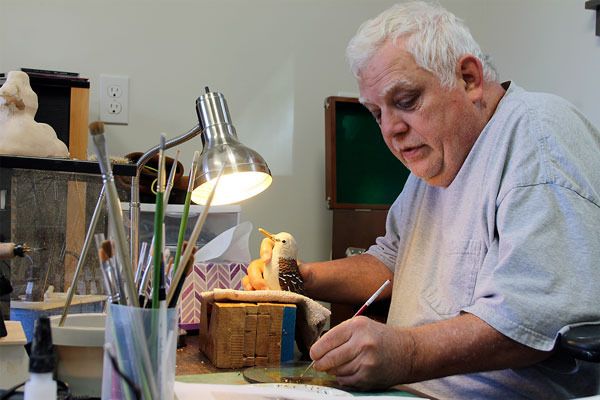For Don Bundy and other woodworkers, artists don’t need a canvas when they can see shapes and forms in nature.
A piece of driftwood could morph into a sculpture or a repurposed shelf, if in the right hands. There is much to do with wood, and a plethora of those possibilities will be exhibited this weekend at the Whidbey Island Center for the Arts (WICA).
Some of Whidbey’s most skilled woodworkers will show their work at Woodpalooza 2016, held from noon to 5 p.m. Saturday to Monday Sept. 3-5 at WICA’s Zech Hall. Sixteen carvers, sculptors and furniture makers from the Whidbey Island Woodworkers Guild will share their pieces from the previous year and discuss their craft and technique with those in attendance. An informal reception will kick off the festival on Friday from 6-9 p.m. and most featured woodworkers plan on attending, according to guild secretary Gary Leake.
“There is so much talent in the guild that’ll be shown, some amazing woodworkers,” Bundy said. “I joined the guild as soon as I moved to Whidbey this past October so I could see what others were working with.”

Bundy is unlike the majority of his colleagues. His small sculptures are typically realist and focused on nature with an emphasis on Pacific Northwest wildlife. While his style is broad and includes abstract art pieces, he’s fascinated by Puget Sound birdlife and carves highly detailed works that resemble the bird from the beak down to the very last feather.
Unlike the others featured, Bundy’s livelihood is not his woodwork. He’s been dabbling in carving for the past 20 years as a hobby, but is serious about his craft. After years of taking classes and conducting research on carving technique as well as avian biology, he now holds his own classes in his retirement years.
And he still finds room to learn from his students.
“I have carving students and a lot of times what we carve is what they want to carve,” Bundy said. “They take me in directions I probably wouldn’t have gone, but I’ve learned a lot from it and broadened my horizons on what to carve and how to carve. That’s how I ended up with the abstract Native American piece in my restroom.”
Bundy also has limited use of his right arm. Although he can clutch his fist, he’s unable to lift his arm after severing the nerve that controls the movement of his biceps in a motorcycle accident where he fell “150 feet” from a cliff and suffered seven compound fractures in the same arm. That would be the end of many carvers’ woodworking careers, especially given Bundy is right-handed, but he’s found a way to continue. He built a customized wooden platform to hold his right hand on his work desk so he’s able to grasp the piece while carving and painting with his left.
“Nature is really gracious to us; it provides lots of opportunities to recreate,” said Bundy. “Sometimes there’s just a shape of driftwood that makes you go, ‘ah, I know how I can use that driftwood in conjunction with what I’m making.’”
Instrument crafter and featured woodworker Janet Lewis has regularly experienced similar reactions to finding the right wood. She said she often jokes of going to the lumberyard and falling in love with pieces she envisions as part of her guitars and ukuleles. For her, the joy of making stringed instruments is the idea that her completion is just the beginning for someone else’s journey.

“Music is universal and touches lives and gives people meaning,” Lewis said. “It’s nice to be able to contribute to that in some way.”
From the woodworkers’ perspective, Woodpalooza is a chance to talk wood with other wood fanatics. Lewis gets joy out of “geeking out with your tools” with other guild members, while Leake is looking forward to exchanging ideas and seeing what others have been working on for the past few months. It’s all lighthearted rather than pitting rivals against one another.
“At the exhibition we take turns talking about our work with the crowd,” Leake said. “In some instances we compete, but generally we talk about pricing and how the market works with the other guild members.”
Eventually, the guild would like to give Woodpalooza an educational role to recruit new woodworkers and encourage amateurs to hone their craft. The group of wood wizards see themselves as laid back and not “hoity toity,” and enjoy sharing their passion with those considering getting into the craft. Someday, Woodpalooza may have a more expansive lineup with graded competitions and workshops for young carvers.
“There is a desire to group together to share the passion with maybe high school kids who are thinking about woodworking careers,” Leake said. “We dream of the day when we have kids from the wood shops competing, as well as classes throughout the festival.”

